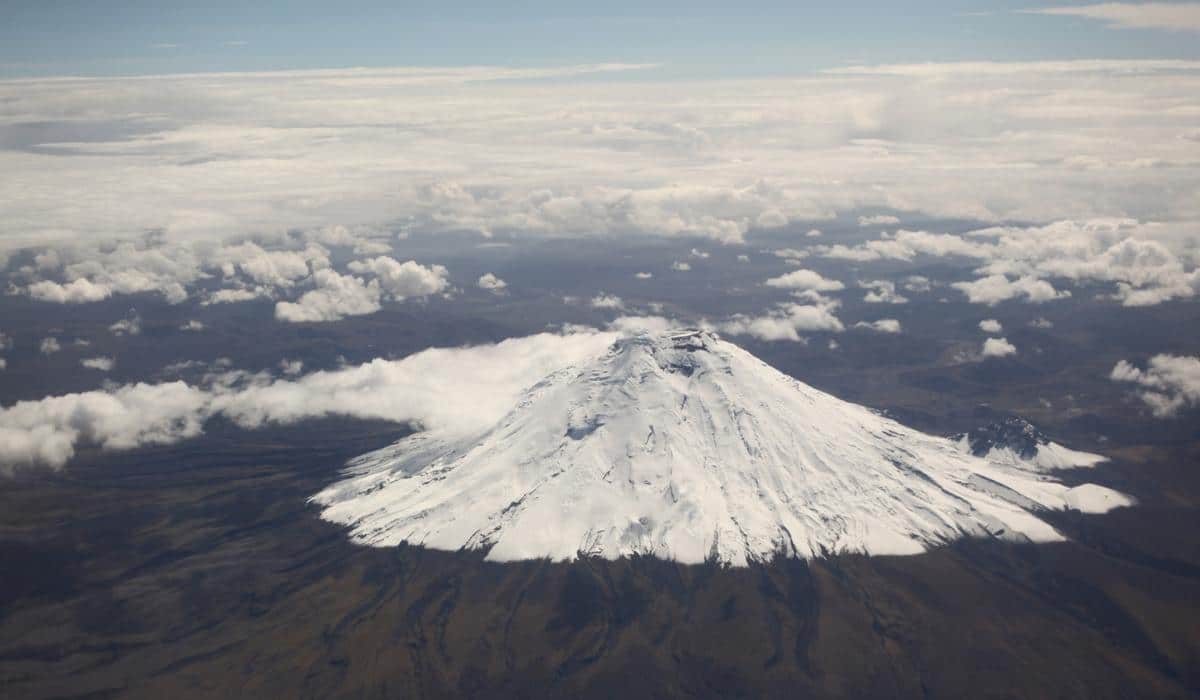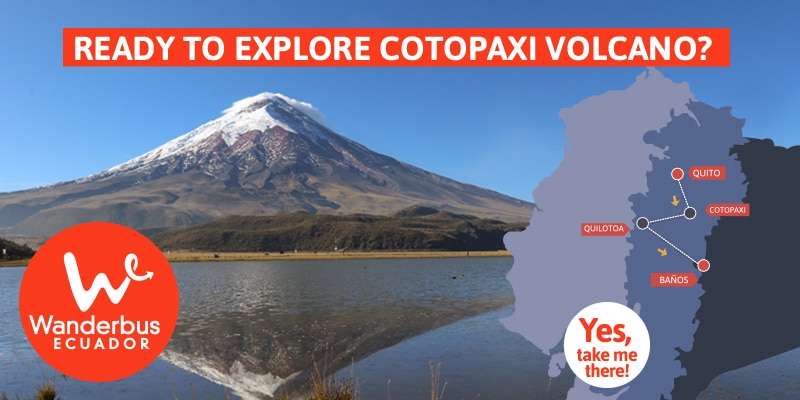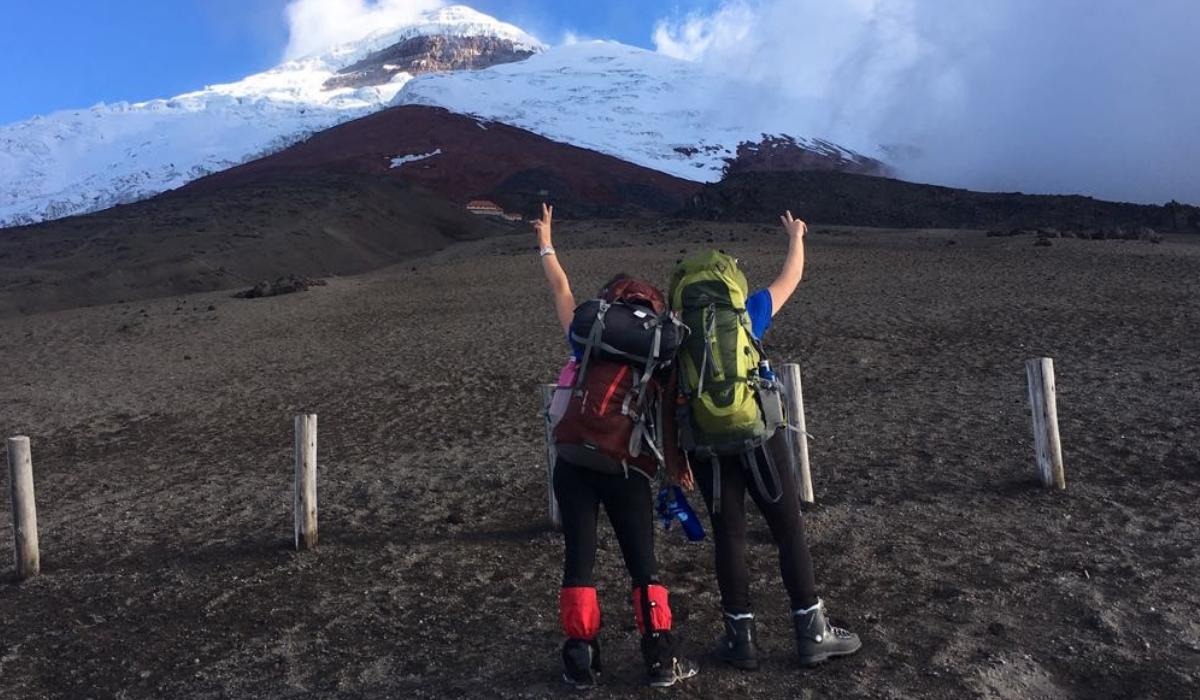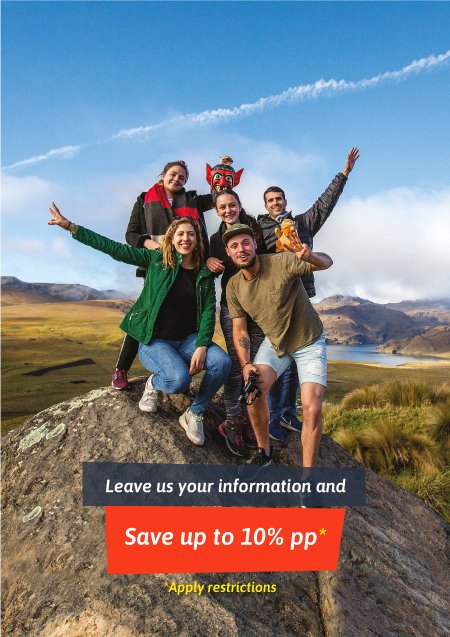
How many opportunities will you have to climb an active volcano? The snow-peaked, classically conical Cotopaxi Volcano looks like something straight out of a National Geographic Magazine and is one of Ecuador’s top destinations. In the following blog, we’ll give you more information on how to get from Quito to Cotopaxi and the things you can do during your visit.
How to get to Cotopaxi
Quito to Cotopaxi by bus:
Public transportation: Getting from Quito to Cotopaxi on public transport is more of a hassle than it needs to be, especially given the proximity of the volcano (about 60 km as the condor flies), but if you’re doing “Cotopaxi on a budget”, this is the cheapest way to visit Cotopaxi Volcano.
In Quito, make your way south to the Quitumbe bus terminal (“Terminal Terrestre Quitumbe”) and hop on a bus headed to Latacunga. To get to Quitumbe, either take the Trole ($0.25) or a taxi ($10-20, depending on the hour).
From Quitumbe, buses leave frequently to Latacunga and you won’t have to wait long to get moving. The ticket to should only cost you $2 per person.
When you get on the bus, make sure the driver knows you’re going to Cotopaxi National Park. This is important because you’ll need to get off the bus at the “Control Caspi”, before arriving at Latacunga. If you’ve never done the trip before, you won’t know when to get off the bus and will likely miss your stop.
Once you get off the bus, you can either hitchhike or flag down a pick up truck (or taxi) that will take you to the main entrance of the park*, which is 15 km (9 miles) away from the highway. Depending on who you flag down, this leg may cost you $30. You should have a photo I.D. with you since park rangers are required to register all visitors for safety reasons.
There are two ways to enter Cotopaxi National Park.
- The main southern entrance is accessible from the highway (where public buses will drop you off), passing through the Control Caspi turnoff.
- The second entrance, called the Pedregal entrance (approximate location), is accessible by pick up truck from the town of Machachi and traverses dirt and cobblestone roads, taking significantly longer but offering great views along the way. This entrance is little more than a hut with a bored park ranger inside. There are no guides and no transportation here. If you’re venturing independently, then it’s best to head to the southern entrance.
Visit top destinations like Cotopaxi, Quilotoa and Baños in just 1 day (or more) with the Jacamar Pass. Book your trip today!

Wanderbus Ecuador: An easy, not to mention fun and hassle-free, way to get get from Quito to Cotopaxi is on a Wanderbus pass, like the Jacamar or Paloma pass.
Wanderbus has predetermined hop on and hop off points in Quito that are closer to the Mariscal and Old Town districts, saving you a trip to Quito’s southern terminal, Quitumbe. Our buses also come with a bilingual guide.
Since many travelers often combine a trip to Cotopaxi with a visit to the nearby Quilotoa crater, Wanderbus offers passes that stop through these (and more) destinations. What’s convenient is that you can hop on and hop off the bus at these locations if you decide you want to stay longer.
The Wanderbus goes from Quito to Cotopaxi on Monday, Wednesdays and Fridays. Pick up times are at 6:00 am and 6:15 am in the Mariscal (Plaza Gabriel Mistral and Plaza Foch) as well as 6:30 am in the Old Town (Plaza Belmonte).
To find out more, chat with one of our sales representatives by clicking on the chat icon in the lower right corner of this screen.
Book a tour operator in Quito: Since Cotopaxi is such a well-known destination, there are a number of tour companies that work out of Quito and offer day trips to the volcano. All elements of the trip are coordinated by the tour operator so the day price for an all-inclusive (including lunch) tour may cost around $115 per person.
Ask at your hostel if they can recommend any tour companies, there are quite a few available!
Is it safe to visit Cotopaxi Volcano?
When Cotopaxi Volcano started erupting in August of 2015, the park was shut down for several months and many locals in the surrounding areas evacuated in case the situation got worse. After many more months of monitoring, officials decided that it was safe to re-open the park.

Today, Cotopaxi National Park is open to visitors and both the glacier and summit hikes are permitted.
While Cotopaxi Volcano remains active and could begin erupting again, Ecuador’s National Geophysical Institute closely monitors all activity to warn inhabitants of the surrounding areas, as well as visitors, of any possible dangers. There are several (very loud) sirens located within the National Park to warn of any evacuation.
Things to do in Cotopaxi
Activities you can do in Cotopaxi may depend on the time you have available and whether you want to climb the volcano itself.
Cotopaxi day trip
Most visitors to Cotopaxi National Park only come for the day. The risk in doing this is that bad weather may obscure any view of the volcano. To increase your chances of enjoying the incredible view of Cotopaxi, we strongly suggest you leave Quito bright and early in the morning since clouds start to roll in at around 11am.
You can also check the weather forecast here before planning your trip.
Hike to Cotopaxi’s Glacier
After arriving at the park entrance, we recommend you continue into the park by car, either hitchhiking or in a passing truck (for a fee), to reach the main parking lot for the hike to the glacier.
The hike takes about two hours each way, going from the parking lot to the Refugio and higher up to the glacier (which is quickly receding due to global warming and the volcano’s activity – welp).
There are two trails you can follow, one involves many switchbacks but is easier for those that tend to get altitude sickness. The second option goes directly up the mountain to the Refugio and is steep. Given the number of times you may have to stop to catch your breath, you might as well take the switchback trail! From the Refugio, the trail continues up to the glacier.
If you enjoy birdwatching and plant identification, you might want to stop by the Limpiopungo Lagoon after your glacier hike.
This peaceful lagoon is home to many native plants and animals that thrive in the arid paramo ecosystem at 4,000 meters (13, 123 feet) a.s.l such as the Andean Teal, the caracara and the alluring Chuquiragua plant.
If you brought any snacks, this is a nice spot to stop for a picnic, weather permitting.
The hike around the lagoon takes approximately 1-2 hours, depending on your pace and the shore facing Cotopaxi Volcano is an excellent spot to capture some photos of the volcano and its reflection.
Have a coffee and late lunch at Tambopaxi Lodge
Heading towards the southern El Pedregal entrance of the park, you’ll pass a red adobe structure on your left-hand side called Tambopaxi Lodge that includes a restaurant and some incredible views of the volcano.
After a long hike up the glacier and to the lagoon, Tambopaxi is a wonderful spot to cozy up with a coffee and order a dish of delicious, locally-sourced trout. The large windows give you an incomparable view of the volcano and, if you stay for the sunset on a clear day, you’ll capture some incredible panoramas of this snow-covered giant. Many climbers use Tambopaxi as a base while acclimating to the altitudes of the Andes.
Two day trip to Cotopaxi
If you’re planning to spend a little more time in Cotopaxi National Park, there are a few additional activities you can do.
Horseback riding
A wonderful way to experience Cotopaxi National Park and get off the beaten track is on a horse tour.
There are a few companies that organize horse tours from Quito, but if you’re already at the park, head over to Tambopaxi Lodge to schedule a tour.
Since tours usually leave earlier in the day in case of bad weather, we suggest scheduling a tour before arriving and planning this on your second day at the park. If you’re not used to horseback riding, you might be quite sore afterwards and not up for a glacier hike.
Along the way, you’re likely to see herds of wild horses, native to the area.
Hike to the ancient Incan ruins, like Pucará del Salitre
Along the backroads of Cotopaxi National Park, you can access Pucará de Salitre (approximate location), an pre-Columbian fortress located at the top of a hill.
The fortress was constructed by the Panzaleos, a pre-Incan local indigenous community of the time, and later modified by the Incas. Archaeologists believe that the fortress was used as a strategic location to monitor passing groups, including the migration of conquered communities.
To get here, you’ll need to enter the park from the North entrance. Only a few signs indicate how to get here so if you get lost, ask a passing vehicle or tour group.
Climbing Cotopaxi Volcano
The Cotopaxi summit is the second highest in Ecuador and reaches 5,897 meters (19,347 ft) a.s.l. Summiting this monstrosity of nature is no small feat!
For the experienced mountain climbers among you, a summit to the peak of Cotopaxi Volcano is a once in a lifetime activity you should do while visiting the area. However, you’ll have to plan this in advance since you’re required to have a local guide and because the success of your summit depends, in large part, on the weather.
The hike to the summit normally begins around midnight and takes 6-7 hours to complete. It is a non-technical hike, but altitude sickness is a risk and all climbers should know how to wield an ice-pick if necessary. In fact, many tour companies and guides require climbers to complete a short glacier-skills training class prior to climbing.
Due in large part to the altitude, this is a very strenuous hike and your fitness level should be above average. Since hikes are usually organized for small groups of people, the fitness level of each participant directly affects the experience of the other participants. If one hiker falls ill due to altitude sickness and has to turn back, the rest of the group will need to descend as well, missing out on the summit.
If you want some practice before attempting this summit, visit a few other mountains nearby like Fuya Fuya, Pasochoa and Ilinizas.
Where to stay in Cotopaxi
If you’re planning to stay the night in or around Cotopaxi National Park, here are a few options you should check out.
Tambopaxi Lodge: The restaurant and views of the Cotopaxi Volcano make this an excellent overnight destination. However, nights here aren’t cheap ($75/per person), unless you opt for the dorms!
The Secret Garden: While not located in Cotopaxi National Park, this is a wonderful hostel on the outskirts of the park with a cozy, community-like atmosphere and some incredible, eco-friendly structures to stay in. Dorm rooms are affordable and all prices include meals as well as some activities. Last, but not least, the hostel also has a hot tub!
Hacienda Los Mortiños: For another luxury experience at Cotopaxi, stay at this old hacienda with vast views of the volcano, a friendly staff, and numerous activities available for guests like horseback riding, cycling, hikes and more.
Tierra del Volcán: A long-standing, well-run and beautiful hacienda in the wilds to the north of Cotopaxi, the house has various options for accommodation (mid to high range) and delicious food. They rent mountain bikes and have fine horses for heading off into the hills.
When to visit Cotopaxi
Since your experience in Cotopaxi depends on the weather, try to plan your trip during the summer months (June to September/October) and avoid the winter months (March-April and October-November).
Plan activities in the morning to make the most of good weather and to get the best views of the volcano. And to play it safe, check the weather forecast before leaving Quito.
Even on cloudy days though, you might get a glimpse of Volcano Cotopaxi that will literally take your breath away (although this might also be attributed to the altitude!).
What to bring to Cotopaxi
Cotopaxi gets COLD. Be prepared for some high-altitude temperatures and wet weather, even during the summer months. Here’s a list of items you should consider bringing on your trip to Cotopaxi:
Warm winter clothes – Especially if you’re planning to hike to the glacier, make sure you have a warm hat, gloves, scarf, and layers to protect you from the cold, wind and rain. Remember, you’ll be hiking at over 4,000 meters (13,000 feet)!
Good hiking boots – While hiking up to the Refugio, you’ll be astounded (and mildly entertained) to see many people hiking up the sandy, rocky trail in tennis shoes or even heels (yes, it happens). You won’t regret bringing a good pair of hiking shoes to protect your feet from the rain and cold.
Sun protection – Ecuador is a land of extremes! While bad weather is the biggest threat to your Cotopaxi adventure, one sunny day on the equator can leave you as red as a lobster. Bring sunglasses, a hat and sunscreen in case you visit Cotopaxi Volcano on a bright, sunny day.
Water – There aren’t many shops once you enter the park so try to bring some of your own water.
Some hostels will have containers to refill your bottles as well.
Snacks – As with water, you won’t find many places to refill on snacks while in Cotopaxi National Park. Make sure you bring a stash of granola bars, cookies, and nuts. High altitude causes your body to burn more calories and, let’s face it, no one wants to get hangry on a glacier.
Photo I.D. – This is required when you register at the various park entrances.
Only a short trip from Quito, Cotopaxi is a must-see destination that should be on your itinerary.
Since weather and clouds can be an issue here, you might even want to plan a visit at the beginning of your trip, as you head down to Quilotoa, Baños and the Amazon, and then at the end of your trip, on your way back to Quito, in case you didn’t catch a glimpse of it the first time.
Are you ready to visit Cotopaxi? Book your Wanderbus pass today!


